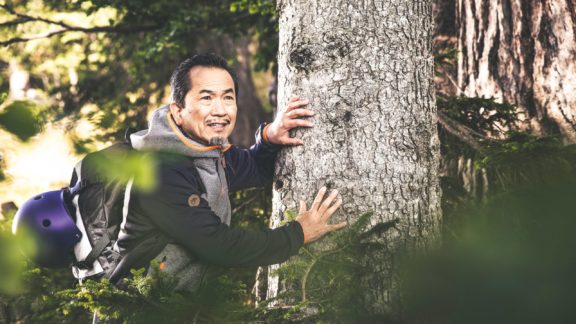In this series, we look at different ways of getting the creative juices flowing. This time, we focus on connecting with nature — how spending time in the great outdoors can improve your health, lift your spirits, boost your creativity, and increase your productivity as a result.
The concept of Mother Nature is rooted in Greek mythology. The primordial Earth goddess Gaia—whose name is derived from the ancient Greek word for “land”—was known as the “Mother of All,” and it is no coincidence that this personification of nature takes on the form of the life-giving and nurturing mother figure, continually striving for harmony and balance in the universe. Throughout history, many cultures and civilizations have worshiped the concept of a mother goddess embodying nature, motherhood, and creation. The word “nature” itself comes from the Latin “natura,” literally “birth.” And if we just stop to appreciate Her once in a while, we will find Mother Nature to be the most generous and inspirational of hosts.
An inevitable consequence of our increasingly tech-filled lifestyles has been a shift toward spending a disproportionate amount of time indoors. We have become disconnected from a natural and plentiful source of energy and inspiration. And it doesn’t take that much effort on our part to reconnect with nature; research suggests that a couple of hours a week is enough to reap the benefits—feeling revitalized, grounded, at peace, and inspired. Is there anything better than breathing in the air after a summer downpour, feeling the wind in your face after scaling a mountain, or listening to the magnificent crash of ocean waves?
Simply put, spending time outdoors is good for you. According to a recent study carried out by the University of Exeter Medical School in the U.K., a stroll in the park, or even just sitting still in nature and drinking in the views, can reduce stress and lower blood pressure, while also boosting mental health. It’s so effective that doctors all over the world have begun prescribing time in nature as an antidote to a raft of conditions such as anxiety, depression, attention-deficit disorder, and child obesity. Hospital patients with views of natural landscapes have also been shown to get better faster. And the recommended dose? Just 120 minutes a week, dedicated to short runs, walks with the dog, or simply the mere enjoyment of green views.
Life moves pretty fast. If you don’t stop and look around once in a while, you could miss it.”
Ferris Bueller
Nourishing the creative muscle
Someone who would likely have agreed with the Exeter study was the philosopher Friedrich Nietzsche. He said: “Sit as little as possible. Do not believe any idea that was not born in the open air and of free movement—in which the muscles do not also revel.” And a large body of research backs up the idea of embracing movement. A study by Stanford University showed that exercise can have a major positive impact on certain types of cognitive efforts involved in creativity. Both convergent thinking—the capacity for problem-solving—and divergent thinking—which involves coming up with original ideas—showed a marked improvement through physical activity.
The Journal of Environmental Psychology recently published research linking creativeness and innovative thinking to the feeling of being connected to nature. According to Carmen Lai Yin Leong of Victoria University of Wellington, connecting with nature requires a willingness to embrace new experiences as well as a spirit of adventure. She says, “Venturing into the natural world often involves physical demands (such as hiking), risks (such as getting lost), and opportunities for uplifting experiences (such as viewing a sunrise from a mountain summit).” Opening up to new experiences forces us to be open-minded, and innovative thinkers must be open-minded in order to break with convention and embrace fresh and creative ideas.
- … that the view from your window can affect your food cravings? According to a recent study in the journal Health & Place, you are less likely to crave unhealthy food if your view is of a natural green space.
- … that even indoor plants can do a lot to lift your mood? Plants contribute to improved air quality by cleaning the air of toxins, and spread an uplifting energy within the indoor space.
- … that even indoor plants can do a lot to lift your mood? Plants contribute to improved air quality by cleaning the air of toxins, and spread an uplifting energy within the indoor space.
- … that the early bird catches the worm? Of course you did. But seriously, getting up early in the morning is a technique used by artists to soak up nature’s creative energy.
- … that Tai Chi, Quigong, and yoga are excellent ways of re-energizing your body and mind, and if practiced outdoors will do wonders for your creative energy.
Disconnect to reconnect
New research also suggests that disconnecting from technology and multimedia and connecting with nature for four days can boost creativity by as much as 50 percent. Ruth Ann Atchley, associate professor of psychology at the University of Kansas, says: “There’s a growing advantage over time to being in nature. We think that it peaks after about three days of really getting away, turning off the cellphone, not hauling the iPad, and not looking for Internet coverage. It’s when you have an extended period of time surrounded by that softly fascinating environment that you start seeing all kinds of positive effects in how your mind works.”
The evidence that creativity can be inspired simply by switching off electronic devices and getting back to nature is overwhelming. Atchley goes on: “These distractions sap our resources to do the fun thinking and cognition humans are capable of—things like creativity, or being kind and generous, along with our ability to feel good and be in a positive mood. Nature is a place where our mind can rest, relax, and let down those threat responses. Therefore, we have resources left over—to be creative, to be imaginative, to problem solve—that allow us to be better, happier people who engage in a more productive way with others.”

Look deep into nature, and then you will understand everything better.”
Aristotle
An antidote to modern life
Author Richard Louv even goes so far as to claim the connection to nature as a human right, having coined the term “nature-deficit disorder” originally to describe the loss of connection with nature felt by children, and later extending the idea to adults as well. Louv says that nature-deficit disorder affects “health, spiritual wellbeing, and many other areas, including people’s ability to feel ultimately alive.” He also embraces the idea that spending a few days in the woods not only improves our health, it improves our cognitive abilities and boosts creativity.
Louv cites how reconnecting with nature inspired Juan Martinez to completely turn his life around. On the fast track toward gang life in South Central Los Angeles, his school principal gave him the choice between detention or joining the eco club. He reluctantly chose the club and was handed an assignment to grow something. He successfully nurtured a jalapeno chili plant, and that simple achievement, combined with a trip to the Grand Tetons, inspired him to become an environmentalist and National Geographic explorer.
We live in a fast-moving world. Which means every now and again we must take steps to redress the delicate balance between mind, body and spirit. The answer lies in nature and its simplicity. The natural world is a rich source of inspiration and our creativity becomes more instinctive the more connected we are with nature. So whenever you’re feeling uninspired, step outside, disengage with the daily grind, take a walk in the park, a dip in the ocean, and before you know it everything will feel all right with the world once again. As Californian fiction writer M.P. Zarrella famously said, “Nature is cheaper than therapy.” And who could argue with that?
The more we connect with nature, the better our understanding of the five elements of nature that balance our lives, and the more we are able to relate to the entire universe. We have always drawn inspiration from the five elements, because we ourselves are made up of them.
Earth
The earth element, the solid state of matter, is a source of structure and stability and represents balance. Yoga and the martial arts, as well as simply walking, standing, or sitting on the ground, are great ways of keeping us grounded, which makes it easier to remain focused on our goals. An imbalance of the Earth element could be manifested by a general weakness in the body.
Fire
The sun is the source of life and energy and fuels the determination and passion to persevere through life’s obstacles. Fire both gives life and takes it away. An imbalance of the Fire element might lead to impatience, greed, and anger, but could also manifest itself as fever, skin diseases like inflammation, or excessive sweating.
Water
Our body—as well as the planet—comprises roughly 70 percent water, making this a vital element. It keeps us hydrated and regulates body temperature, while contact with water washes away toxins and swimming helps soothe the mind and heal the body, freeing us up to be more creative. Water is perpetually flowing, so it is important to allow our feelings and ideas to flow freely, too. An imbalance of the Water element might be manifested by excess mucus, a cold, or sinusitis.
Air
This element is dynamic and represents a capacity for motion. Deep breathing and filling your lungs with fresh air is important for relaxing your mind, bringing peace, and improving concentration. An imbalance of the Air element might lead to anxiety and fear, as well as to physical conditions such as skin dryness, blood pressure issues, lethargy, or insomnia.
Space
Often referred to as the mother of all the other elements, space has no physical existence, and yet exists everywhere. It is the source of all matter, and allows for growth and change to take place. Hence an awareness of space can help us to see the bigger picture. An imbalance of the Space element could be visible as a Thyroid disorder, throat problem, or speech disorder.


